‘BELFAST’ – What springs to mind? The Troubles? Titanic? This city, which is enjoying a resurgence as a tourist destination, has wisely – and cleverly – promoted both legacies in its bid to attract visitors. Many have still to be convinced – assuming there’s nothing here but a pile of rubble in the aftermath of prolonged conflict. What a surprise to discover how much of the grand city of the past is still intact while a vibrant modern city is regenerating around it. Belfast now makes for a brilliant weekend mini break destination or as a base in which to explore the beautiful north east corner of the island. Its just a two hour drive from Dublin and about the same by train. We ourselves have been visiting Belfast for years – going up maybe twice a year for an overnighter. I’ve cobbled together an outdoor trail which takes in most of the city centre and can be completed in just a few leisurely hours. Its looped so you can start from anywhere…..
Before you start:
I think they’ve done a great job with signage at places of interest so don’t worry if you haven’t swotted up on info or downloaded any apps…
City Hall
Well this is as good a place to start as any…. The magnificent City Hall with its green copper dome pretty much defines the city centre. Construction began in 1888 when Queen Victoria awarded Belfast a city status due to its thriving linen and shipbuilding industries. The buildings and grounds are open to the public. Inside, you can admire the marble staircase and other fittings as well as the stained glass windows.


At one side of City Hall is the Belfast Cenotaph (a monument erected to someone who is buried elsewhere, especially commemorating people who died in a war).

The enclosed gardens are dotted with impressive statues and monuments. This is also the location of Belfast’s Christmas Market.
Donegall Square
City Hall is located on Donegall Square. Around the square, many beautiful houses and warehouses have survived the passage of time although a few have succumbed to ‘progress and development’. Nowadays, those buildings that have survived generally house banks and insurance companies but you can still get a sense of former glory…

This is very much the heart of the city. Pay a quick visit to the Tourist Office here on the Square for maps, suggestions and current events.

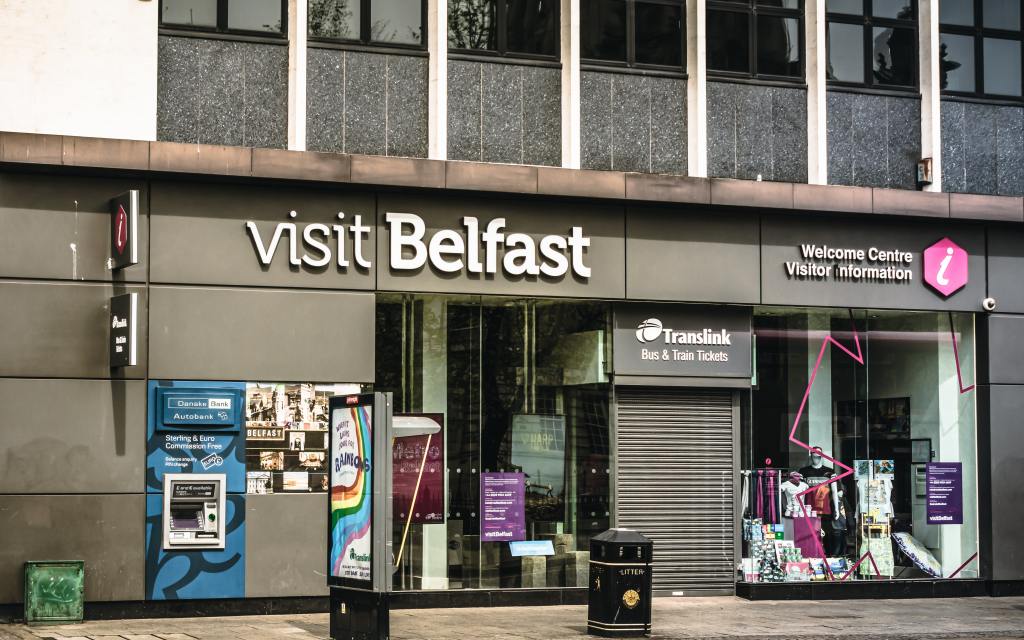
Why does it always rain on me….. seriously!!!

Walk along Donegall Square West – (City Hall and the Cenotaph are on your left) – and continue onto Bedford Street.
Ulster Hall
This live entertainment venue has been on the go since 1862. It must have some stories to tell! Charles Dickens read passages from A Christmas Carol here in 1867. Winston Churchill was scheduled to speak here in 1912 but was barred because of his support for Irish Home Rule. Down through the decades, it has hosted political rallies for both Republican and Loyalist groups. Led Zeppelin’s first performance of Stairway to Heaven was here in 1971. The Dalai Lama spoke in 2000…..

Thomas Thompson Memorial Fountain
Although Belfast’s inhabitants were not directly affected by the Great Famine (1845 -1849), refugees thronged from the surrounding countryside bringing illness and disease with them. Thompson was a naval surgeon who was appalled by consequential conditions and founded the Charitable Home for the Incurable. The Red gothic styled memorial fountain (1885) carries the inscription Whosoever drinketh the water that I shall give him ..shall never thirst again

Turn right onto Bruce Street. Cross over Great Victoria Street and into Hope Street / Sandy Row
Sandy Row
The best way to develop an understanding of Northern Ireland’s history and the legacy of ‘The Troubles’ is to take one of the famous Black Taxi Tours. This hugely informative and rewarding tour typically lasts about 90 minutes and will take you to some of the areas – from both sides of the divide – most associated with the Troubles.

Just across from the King William mural is the impressive Murray and Sons Tobacco Company building. How splendid it must have looked when first built in 1900. Rescued from dereliction, its now an office block.

Mother Daughter Sister
This piece on the corner of Sandy Row was the result of months of consultation with various women’s groups.
In the words of sculptor Ross Wilson This sculpture celebrates the dynamic female culture and identity of Sandy Row and the generational contribution women have made to this community both in the family and work place. Mother Daughter Sister has its beginnings in Sandy Row’s past but encourages all women to follow their dreams with hope-filled hearts into a hope-filled future.

Backtrack and turn left onto Great Victoria Street….
The Crown Liquor Saloon
Originally a railway station restaurant, this pub is one of the most famous in the city – primarily for its lavish decor, both inside and out.

Monument to the Unknown Woman Worker
Across the road from the Saloon, at the entrance to the Train Station, is a 1992 sculpture by Louis Walsh which focuses on women’s rights issues of low paid jobs and unpaid housework. Its worth spending a few moments examining the piece – you’ll find all sorts – domestic symbols such as a colander, clothes peg and shopping basket and work symbols like the typewriter and phone…. That earring, if I’m not mistaken, is a baby’s soother?

Europa Hotel
This four star landmark is one great survivor! Europe’s most bombed hotel (over 30 times during the Troubles), it was nicknamed the ‘Hardboard Hotel’ because of the number of times its shattered windows were covered over!
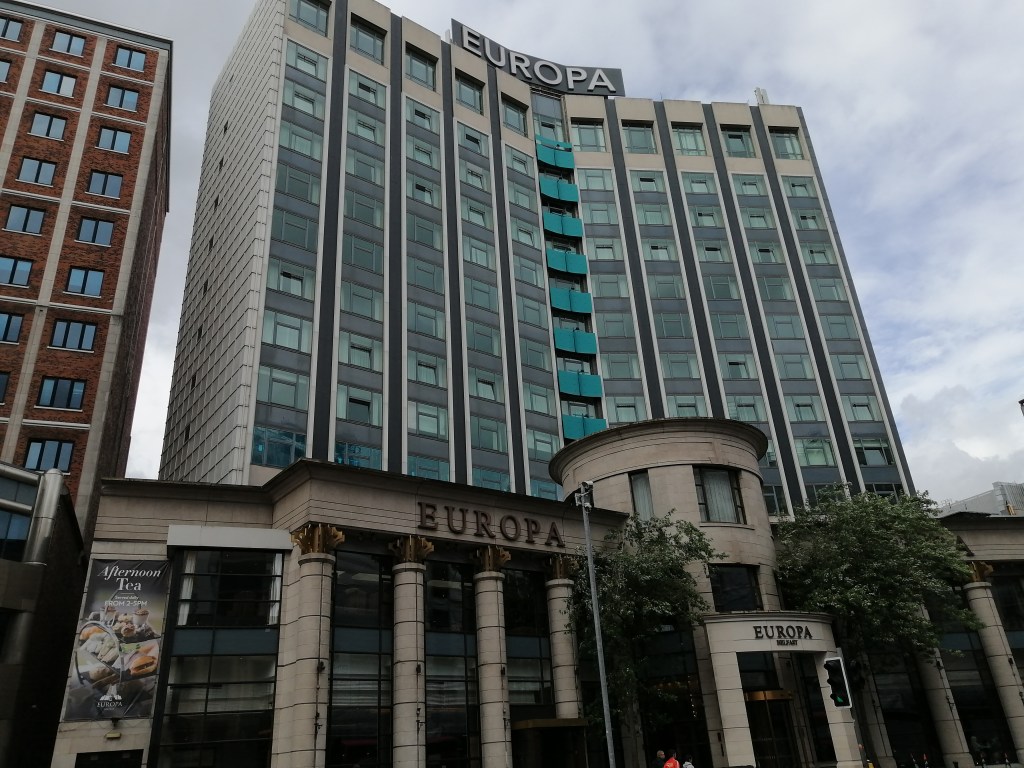
Opera House
Originally named the Palace of Varieties, the beautiful Opera House opened its doors in 1895. It has survived frequent bomb damage (usually when the nearby Europa was being targeted) and continues to host musicals, drama and live music events.
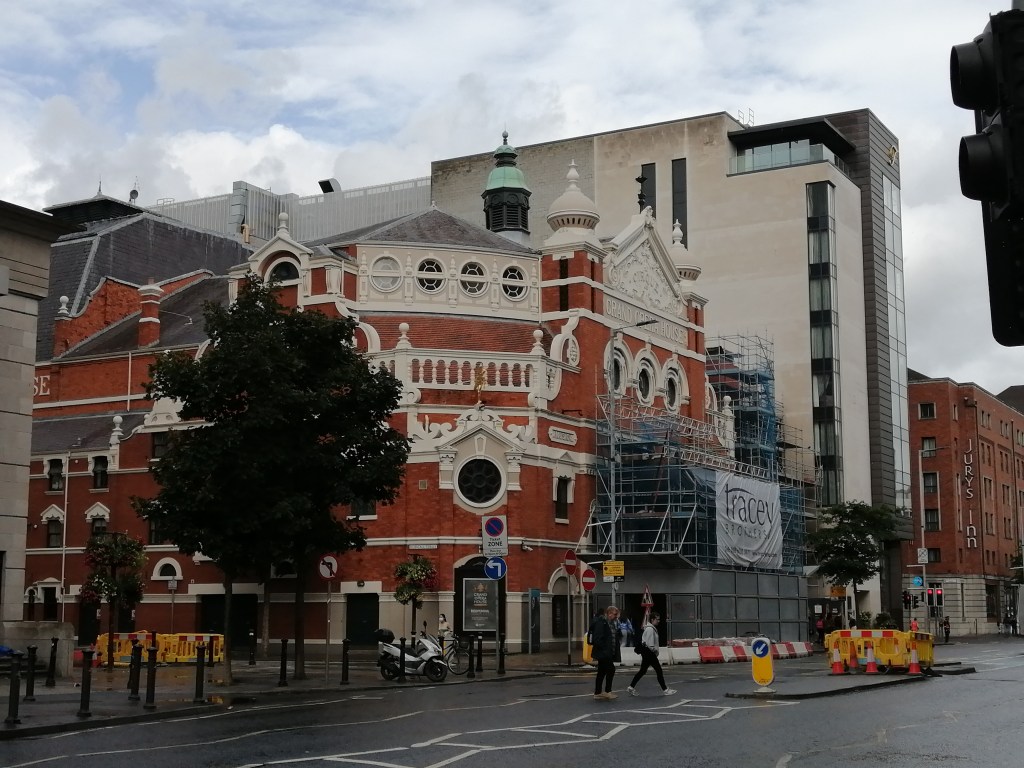
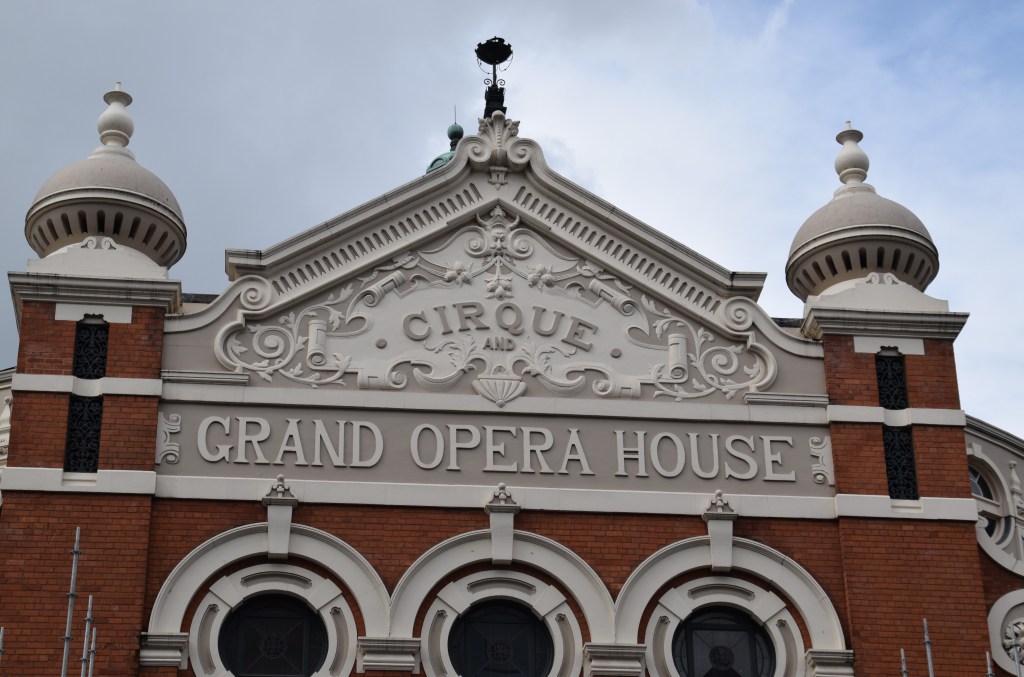
The Spire
I love this building. It used to be the headquarters of the Irish Presbyterian Church, and today houses Spires Mall Shopping Centre.
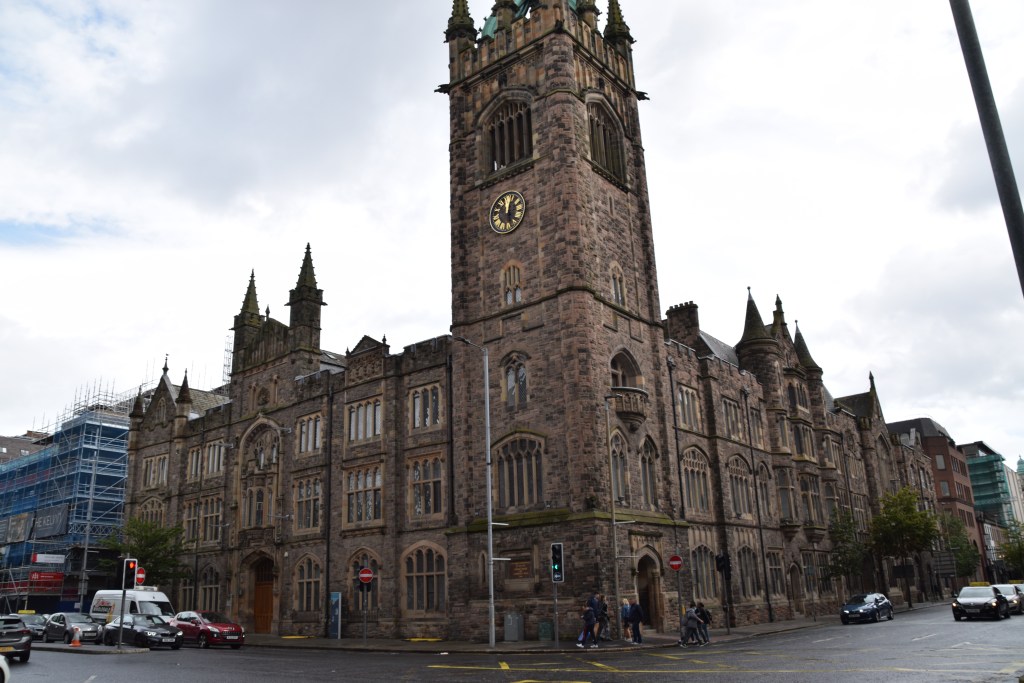
Royal Belfast Academical Institute
This prime piece of real estate is actually a boys grammar school with over a thousand pupils aged between 11 and 18 years.
The beautiful building next door to the school is a reminder to keep looking upwards on your walk!

Turn right onto College Street, left onto Queen Street and continue onto Chapel Lane….
St. Mary’s Catholic Church
The 1782 census records only 365 Catholics living in Belfast. The local Church of Ireland and Presbyterian congregations donated funds towards the building of St. Mary’s and the first mass was celebrated on 30 May 1784. The Catholic population grew and St. Mary’s was enlarged in 1868 while other Catholic churches were built around the city.
In 1954 a Grotto to Our Lady of Lourdes was established in the gardens of the church.

Street Art
The Belfast Street Art scene is not confined to political murals of course. Keep your eyes open as you walk around the city or, if you’ve time, join a Street Art Walking Tour which introduces you to a whole new way of viewing the city.



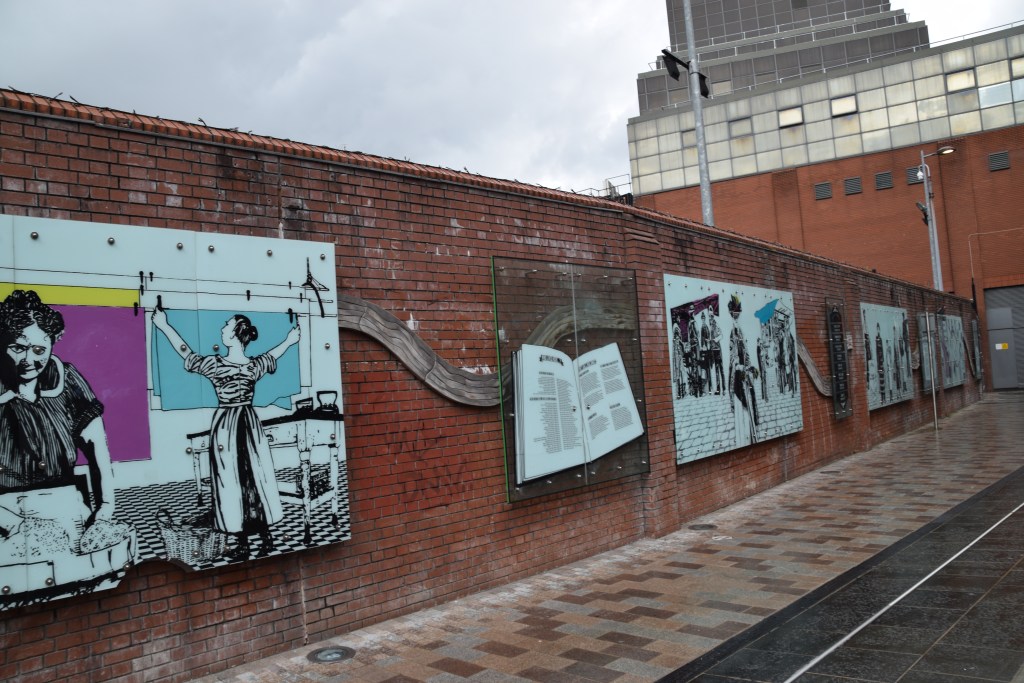
City Centre Shopping
Castle Court and Victoria Square have the usual big retail names and brands but nothing remarkable. I was delighted, on my last visit in August, to come across CRAFT NI on Royal Avenue which showcases a lot of Northern Irish jewellery, art, gifts, etc….

Leave the shopping zone and head up Royal Avenue (away from City Hall)….
Bank of Ireland
This beautiful 1928 Art Deco building lay empty from 2005 when Bank of Ireland relocated its HQ. It one of the very few examples of this architectural style in the city and caused upset as it fell into disrepair. It made the news a few years back when Take Back the City campaigners began squatting there in protest. Latest news is that fresh plans have been submitted for its redevelopment.
Belfast Central Library
Heading towards the Cathedral Quarter, you’ll come across some lovely red sandstone buildings. One of these is the Central library. Opened in 1888, this was one of the first major library buildings in Ireland.
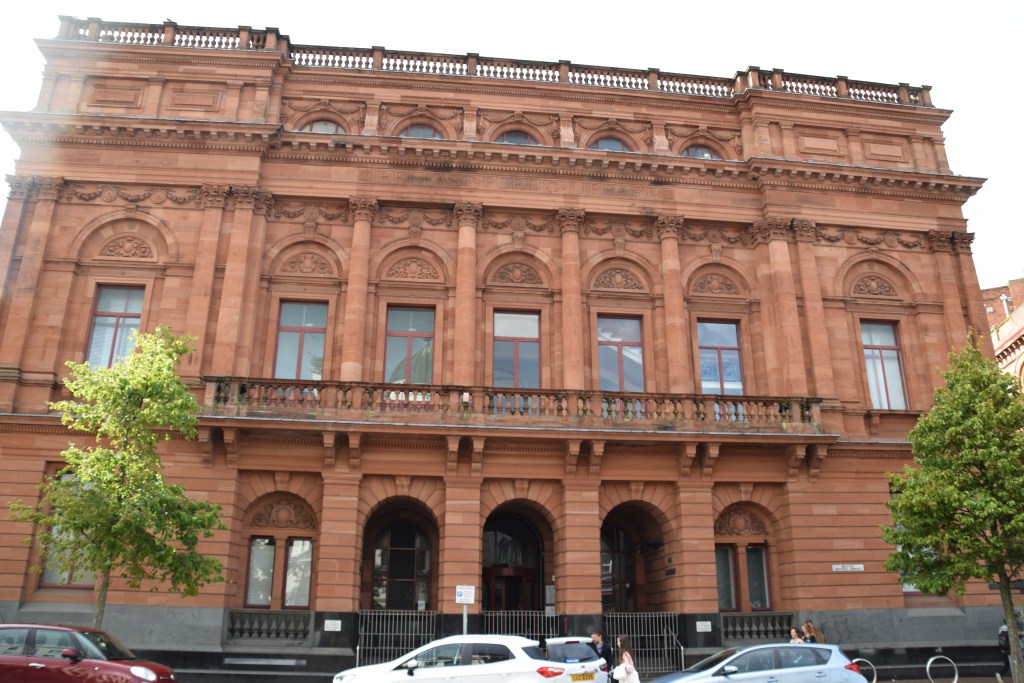
What a beautiful corner

Cathedral Quarter
Go into St. Anne’s Church of Ireland Cathedral to see the mosaics, stained glass and carved stonework. Built in 1899, the ground here is soft so the church is supported by 50-foot-long wooden piles. It is believed that this is also the reason the cathedral has no central tower and spire.

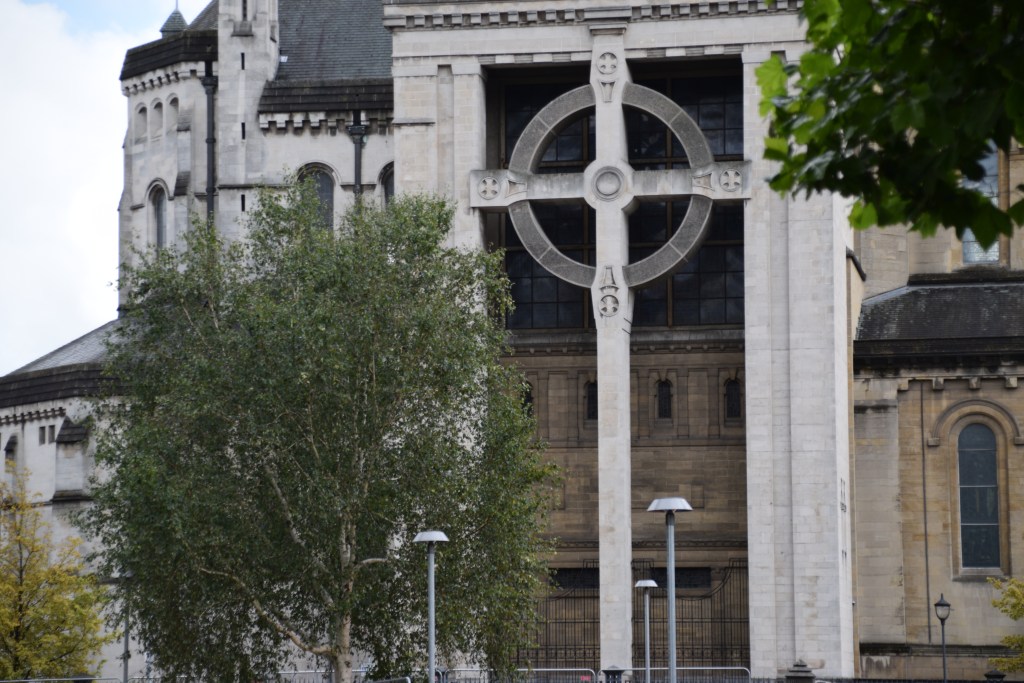
In 2007, a distinctive contemporary addition to the cathedral was installed in the form of a 40-meter stainless steel spire named the “Spire of Hope.”

The cobble stoned streets around the Cathedral have become quite a hub for bars, restaurants, clubs and art installations.

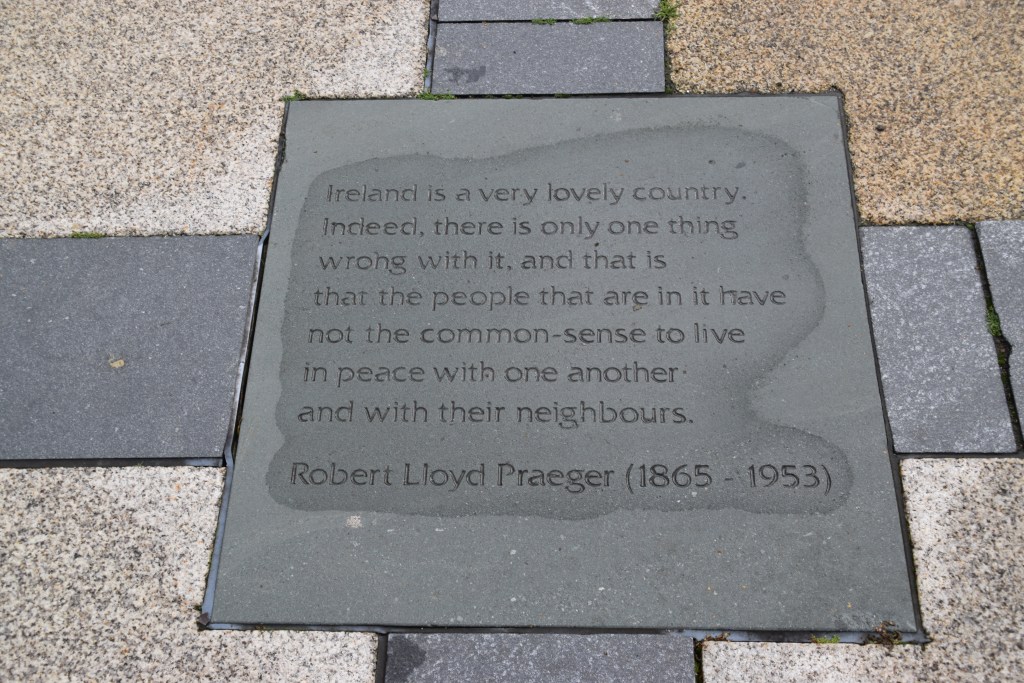

The Calling (2003, Paddy McCann)
Merchant Hotel
This 5* hotel in the Cathedral Quarter began life as the HQ of Ulster Bank. Built in the mid 1800’s, the beautiful facade is topped with sculptures of Commerce, Justice and Britannia.


After wandering through the Cathedral Quarter, make your way to Victoria Street – Head towards the clock…
The Albert Clock
Dedicated to Queen Victoria’s husband, Prince Albert, you’ll find this 1869 landmark close to the docklands. Of enormous weight, and built on wooden piles on marshy land near the river Farset, it didn’t take long for it to begin tilting and its affectionately known as Belfast’s leaning tower of Pisa.


Custom House Square
This was an important trading area in Belfast, causing the Custom House to be built 1854 -1857. The steps of the Custom House were used by public speakers and evangelists during the 19th century. Today, the statue of ‘The Speaker‘ stands on the steps in commemoration.



Trivia Moment – Novelist Anthony Trollope invented the LETTER BOX! (bet you never thought of it as an ‘invention’ – I certainly didn’t!)
The Quays
The River Lagan runs right through the heart of Belfast and there has been a huge amount of regeneration and development here over the past two decades.





The Big Fish
Also known as the Salmon of Knowledge, this 10metre landmark was produced by John Kindness in 1999 to celebrate the regeneration of the area. Its blue ceramic scales are covered with scenes of local history, newspaper cuttings and everyday life. Inside, the city has stored a time capsule for future generations.

Beacon of Hope
Created from steel tubes and cast bronze, this installation stands an impressive 19.5 metres high overlooking the river. The woman holds the Ring of Thanksgiving above her head. At her feet, a globe symbolises the places to which Belfast people have emigrated down through the centuries. Needless to say, the piece has been rechristened by locals…. Nuala with the Hula, The Doll with the Ball, The Thing with the Ring!!!

Samson and Goliath
Surely one of the most iconic sights in the city, the massive Harland and Wolff cranes off in the distance dominate the Belfast skyline. Goliath was completed in 1969 at a height of 96 metres, while Samson was finished by 1974 and stands at a huge 106 metres, making them still the biggest free-standing cranes in the world.

Across the River
We’re not crossing the river today on this walk, and its most likely that you’ll be heading out to the Titanic anyway if its your first time in Belfast, but a quick word about this major attraction…
The RMS Titanic – then the biggest ship in the world – was built here in Belfast by Harland and Wolff in what was the world’s biggest shipyard, employing 15,000 people. Titanic was completed after twenty six months of construction and set sail from Southampton in England before infamously sinking on 14 April 1912.
Titanic Belfast opened in 2012 and has drawn great attention, winning awards of excellence as one of the world’s top tourist attractions. It consists of several levels of museums and galleries, reconstructions, event spaces, and interactive experiences. Visitors follow the self-guided journey from conception stage, building and on through to the tragic maiden voyage.
The aluminium and crystalline building itself is stunning. Shaped like a ship’s bow – or an iceberg? – its supposedly the exact height of the ship from keel to bow.
Belfast loves its ‘Quarters’. There is Queen’s Quarter (University), Gaeltacht Quarter, Linen Quarter, Market Quarter, Cathedral Quarter and now Titanic Quarter. As well as the Titanic Museum there is the Titanic Hotel, Titanic Creative Studios, the 11,000 seater Odyssey Complex and plenty of restaurants and apartments.
If you want to include this on your trail, Titanic is a mile walk from the Big Fish.

(Stock photo – obviously!!!!! As if I’d get a day like that!!)
Waterfront Hall
This well known conference and entertainment venue was one of the cornerstone projects of the riverfront redevelopment plan.


Outside the Hall is this rather unexpected scene… Sheep on the Road depicts a somewhat unlikely city centre spectacle nowadays. These bronze statues of a shepherd ambling after his flock serve as a reminder of the country’s ingrained aricultural traditions that are still such a way of life.
Game of Thrones
Did you honestly think you’d get around the city without encountering some reference to the series which filmed several scenes in multi locations across Northern Ireland. I love this – you can recognise everyone!
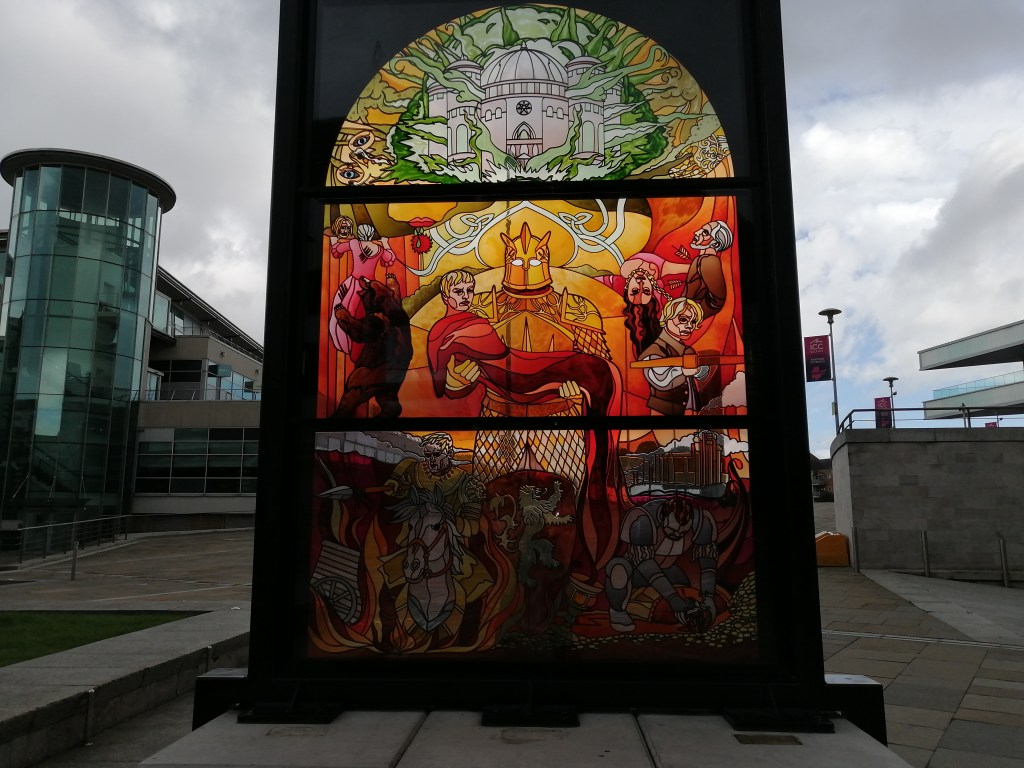
The Boat
This, I think, epitomizes a regenerated and renewed Belfast. The 14 storey building – and name – were inspired by its riverfront location- the coloured squares represent sails…. If you’d a spare £1,000,000 in 2019 you could have bought the penthouse – must have amazing views!

St. George’s Market
Built in the late 1800’s, St George’s is now the oldest Victorian covered market in Belfast . It opens from 9am to 3pm every Friday, Saturday, and Sunday and bustles with traders, food vendors, craftspeople and musicians. Its a great place in which to sample local produce and products.
Royal Courts of Justice
Across the road from the market is the very impressive Royal Court complex. Built in 1933, its home to the High Court, Court of Appeal and Crown Court (on the neighbouring site, the Laganside Courts house six Crown, five County and five Magistrates Courts). Needless to say, the Royal Court was targeted during the Troubles and suffered bomb damage. It was concealed for years behind huge security screens but, nowadays, a public space has been landscaped and pedestrianised.

With the market on your left, head up May Street….
May Street Church
As you make your way back towards Donegall Square, you pass by May Street Presbyterian Church which opened in 1829. At that time, the town centre would have been over towards the Cathedral Quarter of today so this church would have been on the edge of town and surrounded by green fields.

And so we arrive back at Donegall Square. I hope you’ve enjoyed your walk!









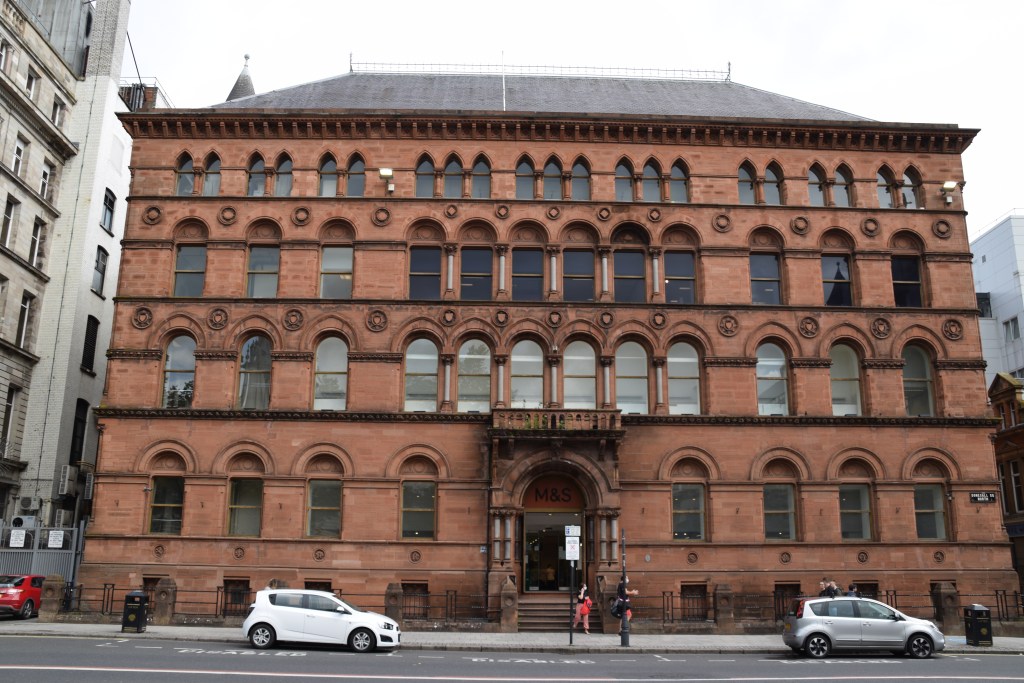
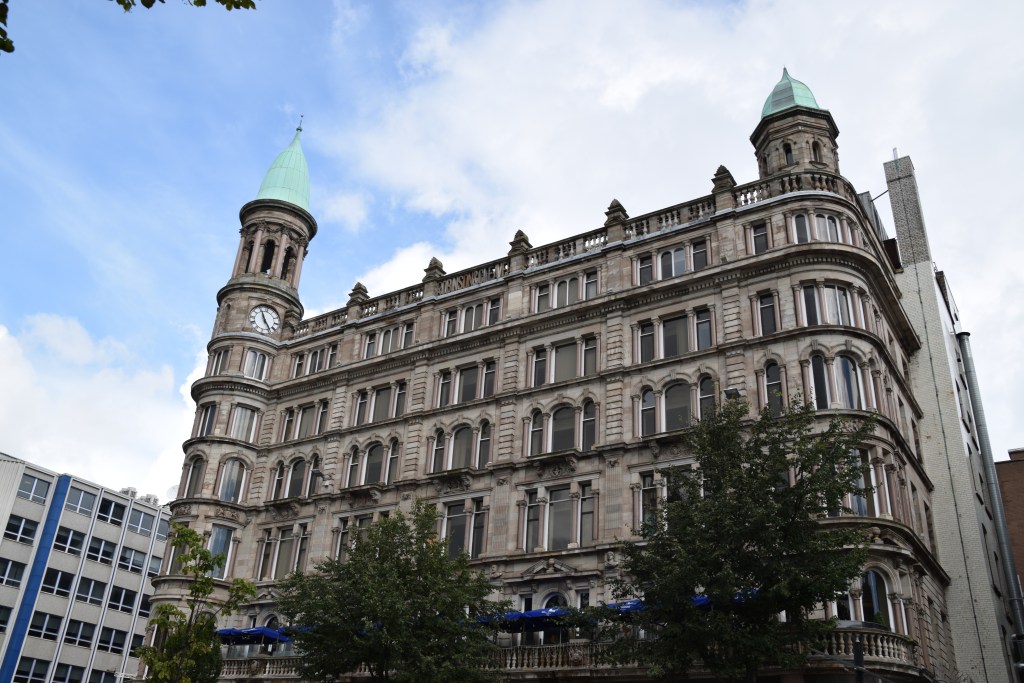





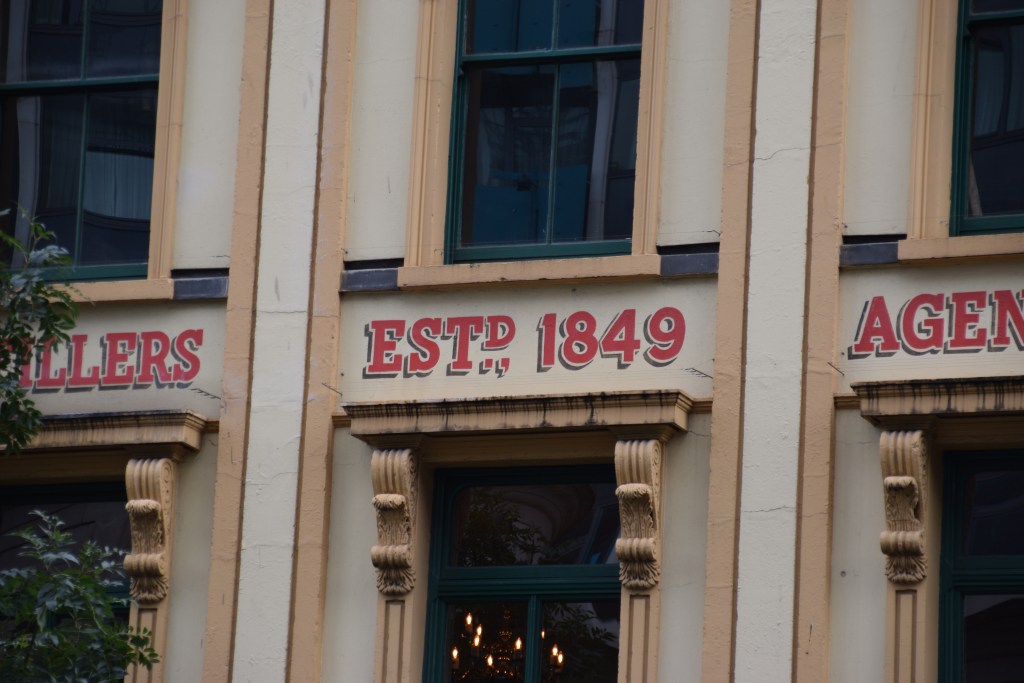









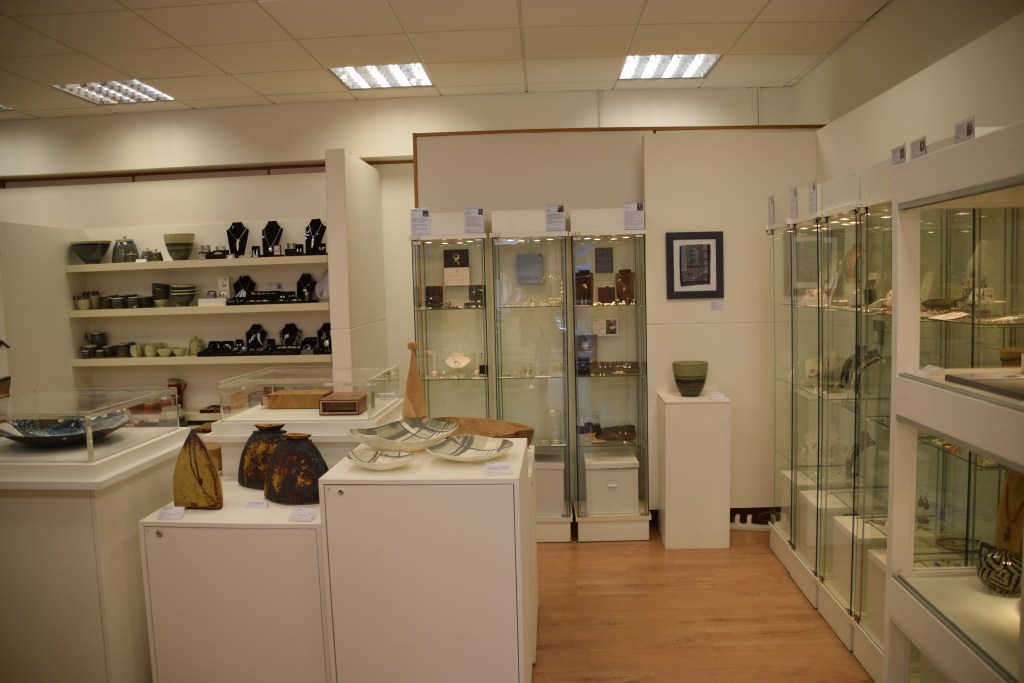















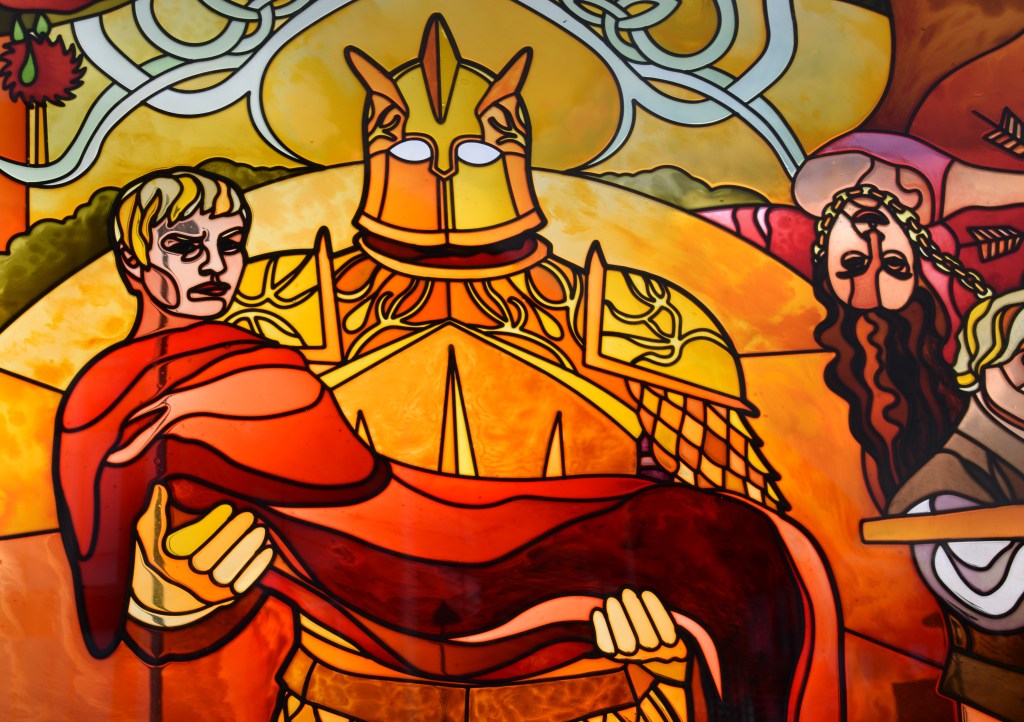
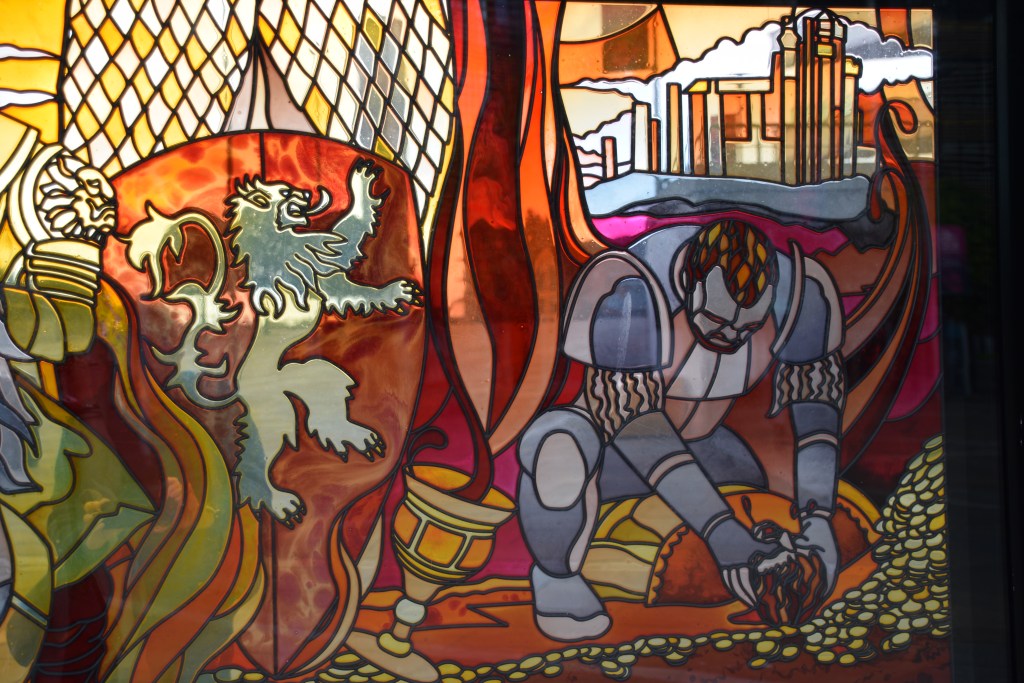

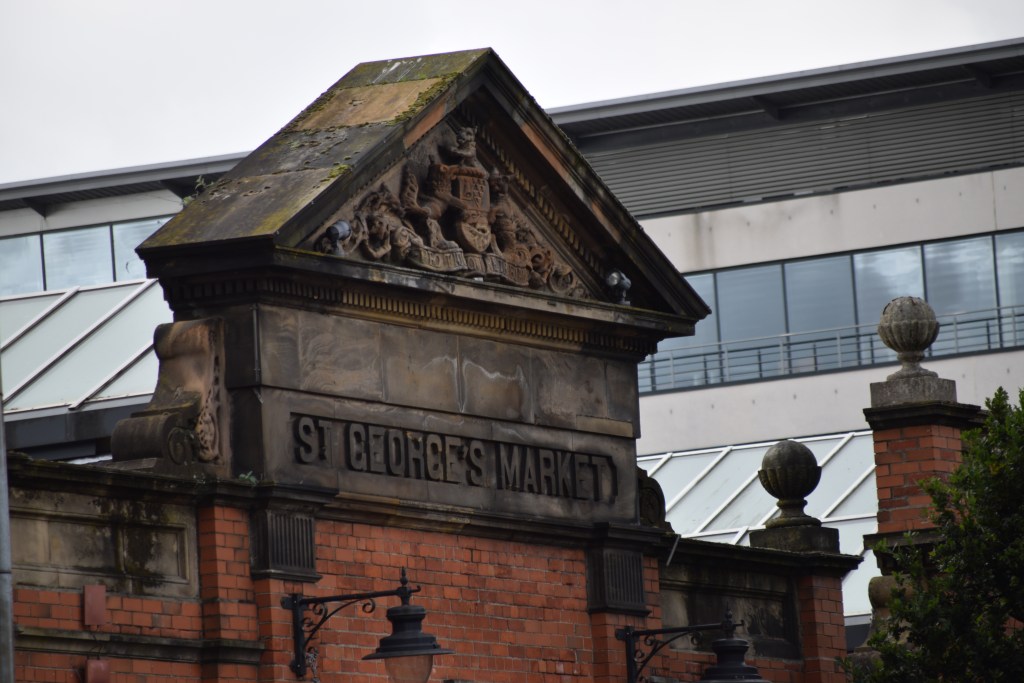






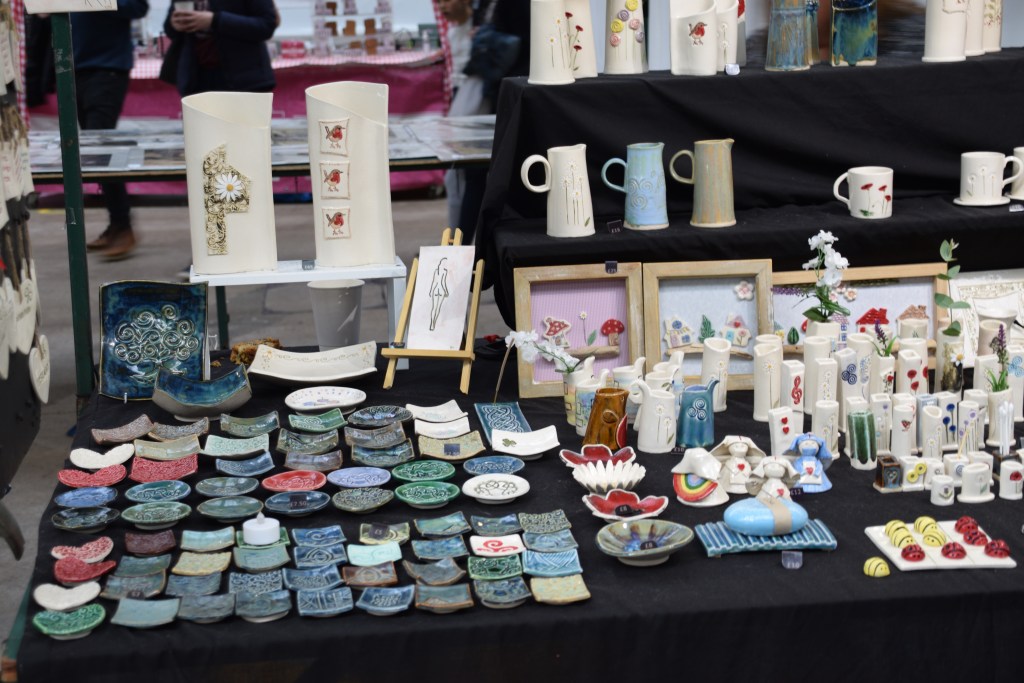
We only briefly bounced through Belfast on our way to the Giant’s Causeway. Looks like Belfast has a lot going on. Hope to get some day for better look. Thanks for sharing Marie. Allan
Its definitely worth a day or two’s attention. What did you think of the Giants Causeway? From photos, I’ve always expected it to be a bigger site….
Loved the Giant’s Causeway. We were there on a beautiful fall day in 2008 and also went to Carrick-a-Rede to cross the rope bridge. Maybe the photos and the legend of Fionn mac Cumhaill make it seem like the Giant’s Causeway is much bigger, like the legend. Stay well Marie. Allan
We’ve never made it to Carrick-a-Rede in season so the bridge was never open to us. Its a nice coastline…
XXXMarie
It’s a great post. I saw the Titanic being constructed, I mean the museum, obviously I’ll have to come back to see it finished, as well as everything you show from Belfast that I haven’t seen.
Titanic is definitely worth a visit – they’ve done a great job on it I think. I’d say you’d notice big changes around the city now…..
What an excellent tour, thank you. You have see that was a lot of money in Belfast, back in the day! All those beautifull buildings. I love all the modern murals and scultures. It’s clearly a vibrant city. I have only visited it once back in the 1990s where the highlight was the visit to the Crown and it’s beutifully tiled interior.
They’ve done a lot of work since the 90’s… It still doesn’t attract huge crowds from the south I’d say – the shopping isn’t as good as it was years ago – there’s nothing there now that isn’t in Dublin. You can have a grand tour once you’re back on your feet!!!
I did indeed, enjoy my walk that is, through familiar streets and places, ending in my favourite spot, St. George’s Market where my memories lingered as I remembered shopping there for Christmas presents last year. As to why it rains on you, well you know girl, you do live in Ireland and without the rain you wouldn’t have the intense green of the countryside.
We were lucky to hit Belfast on the weekend so the market was open…It’s really impressive – lots of nice stuff.
As for the weather – I’m CRAVING a parched landscape!!
Me too!
Thanks for this great in-depth tour of Belfast. I was there as a kid in the 70s and of course it was very different. My memories wouldn’t make it a place I’d want to see again but your pictures are of a completely different place. Maggie
A changed place…. shopping centres, boardwalks, restaurant districts….. and yet the same city…. You’d find it very interesting because of memories from the terrible 70’s.. XXXMarie
I can back up what Marie says, it is a changed place. I was there in the 70s also and you wouldn’t recognise it today. You could say it’s quite a sophisticated place nowadays with piano-bars and great restaurants but the craic is still there and the edgy Belfash humour.
ok you two are convincing me 🙂
That’s given me a great look at Belfast. Thanks.
Glad you enjoyed…. XXXMarie
I’d like to visit Belfast, beautiful photos
Its well worth a visit – hope you get there some day ….. XXXMarie
One of your best posts Marie – the Tourist Office people ought to commission you to make it into a booklet. A city I’ve only visited briefly on a day trip to Stormont to watch a bit of cricket 🙂 Must visit at some time.
What lovely words Roy – You’ve made my day!